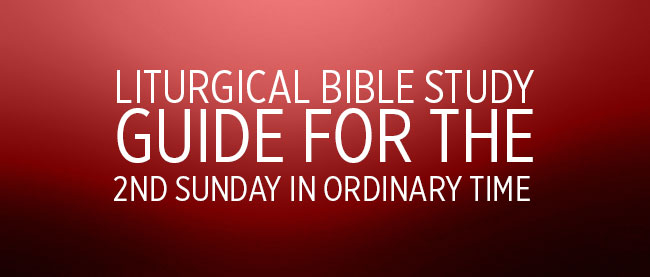1st Reading – Isaiah 49:3, 5-6
The Jerusalem Bible titles this reading “The Second Song of the Servant of Yahweh”. There are four servant songs in Isaiah (42:1-7; 49:1-7; 50:4-9; 52:13-53:12). They describe poetically the person (or nation) that will bring people to an awareness of God’s power, justice, and love. The servant will do this by his whole way of living, but most of all by the way he will bear the suffering brought about by the evil acts of the people. In his suffering, he will justify the people so that they can be restored to God after their separation. The early Church looked back to these servant songs of the Old Testament and began to see how clearly they defined the life and death of Jesus. This second Song of the Suffering Servant deals more with the “call” of the servant. He was called “from the womb.” The “light” theme of Epiphany is picked up in the last line of this reading.
2nd Reading – 1 Corinthians 1:1-3
We now begin a study of the first part of 1st Corinthians; a study which will continue until Lent. During the period between Epiphany and Lent we study the first part of 1st Corinthians during Cycle A, the middle part of 1st Corinthians during Cycle B, and the last part of 1st Corinthians during Cycle C.
Corinth was one of the most important commercial cities in the Roman Empire. Occupying a strategic position on the isthmus which linked the Peloponnese Peninsula to continental Greece, it had two ports; one on the Aegean Sea and one on the Ionian Sea – it was virtually an obligatory stop on the route from Asia to Italy.
According to Homer, Corinth was founded in the 9th century B.C. and saw its heyday in the 6th and 5th centuries B.C. with its schools of rhetoric and philosophy (the tomb of Diogenes was one of its proudest monuments). In 146 B.C. it was razed by the Roman General Lucius Mummius Achaicus; 100 years later Julius Caesar founded a new Roman colony on the ruins of the old city, giving it a new prosperity which lasted for three centuries.
Corinth was the capital of Achaia (Achaia and Macedonia were the two provinces into which the Romans divided Greece). It was also the residence of the Roman Proconsul. In the 1st century A.D. it had a population of some 600,000, making it the largest city in Greece. Up to 2/3 of the population were slaves, the rest being mainly Roman families. Since it was a key trading center, it had a cosmopolitan population – including people from Asia Minor, Phoenicians, Egyptians and others. And it had a Jewish community of some size, as can be seen from the fact that there was a synagogue in the city (Acts 18:4).
It was also a city with many different religions and with temples dedicated to all sorts of gods – and it was notorious for its low level of morality. Life “Corinthian style” was synonymous with depravity. Its aberrations included the cult of Aphrodite, which had 1,000 “priestesses” who practiced what was euphemistically called “sacred prostitution.” Saint Paul preached the Christian message in this city, and God’s help enabled him to found a flourishing Christian community.
Gospel – John 1:29-34
Each year the Gospel reading for the 2nd Sunday in Ordinary Time is from the gospel of John. Why, I don’t know.
In our reading today, Jesus is recognized by John the Baptist. The time is the beginning of Jesus’ public ministry. John the Baptist is baptizing in the Jordan River.


